If you're traveling to Florida, I bet you want to go out there and see some Alligators. And you should! There's nothing quite like an encounter with an apex predator in the wild.
The problem?
Many online lists will send you to the wrong locations for gator spotting. Looking at most of them, I just shake my head and roll my eyes.
So, I decided to create my own list where I share the best places for you to see alligators in Florida, along with some viewing tips.
In a rush and just need my list of top viewing spots for Florida alligators? Here it is, based on our own experience—
The Orlando Area
- Circle B Nature Reserve
- Lake Apopka Wildlife Drive
- The Orlando Wetlands
- Black Bear Wilderness Area
Other Places in Florida
- Everglades National Park
- Myakka River State Park
If you come in the right season, I can pretty much guarantee that you'll see alligators in the above locations.
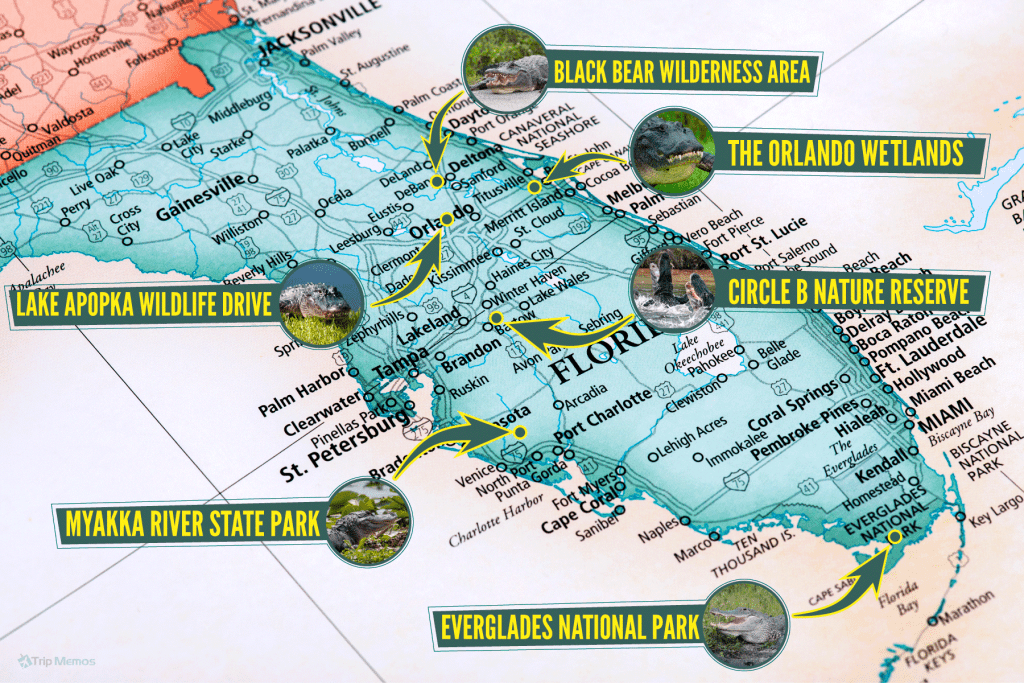
Brace yourself. This will be a long post. If you don't have a lot of time right now, I suggest you bookmark this page and get back to it later because every aspect here is important.
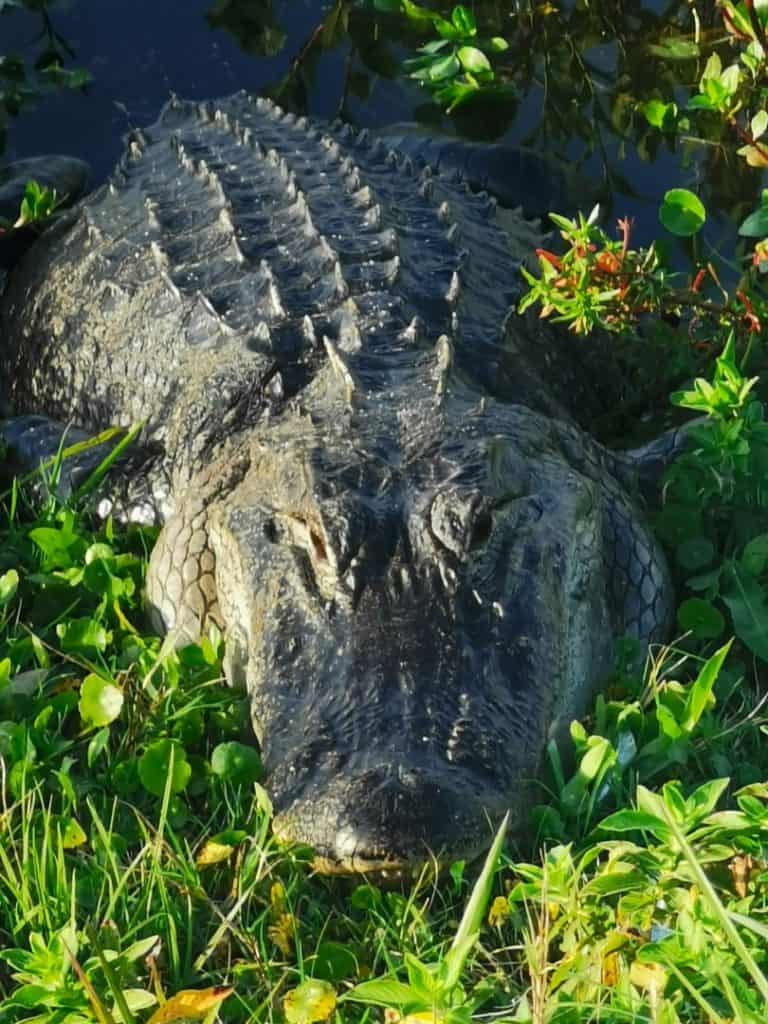
How come I know so much about alligators
Between the summer of 2021 to the summer of 2022, our family spent an entire year in Florida.
We lived in central Florida, not far from Orlando, and we toured various parts of the state.
During that year, we got to see hundreds and hundreds of alligators.
We saw baby alligators, huge 14-foot-long alligators—and every size in between, including some close encounters on the trails (I share the pics and videos in this post).
I also spent a lot of time reading up on these amazing creatures and joined a couple of Facebook groups dedicated to Florida alligators.
I can safely say that I know how to help you find alligators during your trip!
Let us begin our journey into the wilder and scaly side of the Sunshine State.
Where can you find alligators in Florida?
Newsflash: Every body of water in Florida may be home to one or more alligators.
It does not necessarily mean that there is one in every retention pond - but the possibility exists. When we lived in Central Florida, our neighborhood's retention ponds had alligators.
Whenever you're near a pond or any body of water in Florida, keep your eyes peeled and you may just get a glimpse of one.
We even saw an alligator in a city pond once. This little guy is in Titusville, FL (this is not a zoo!) -
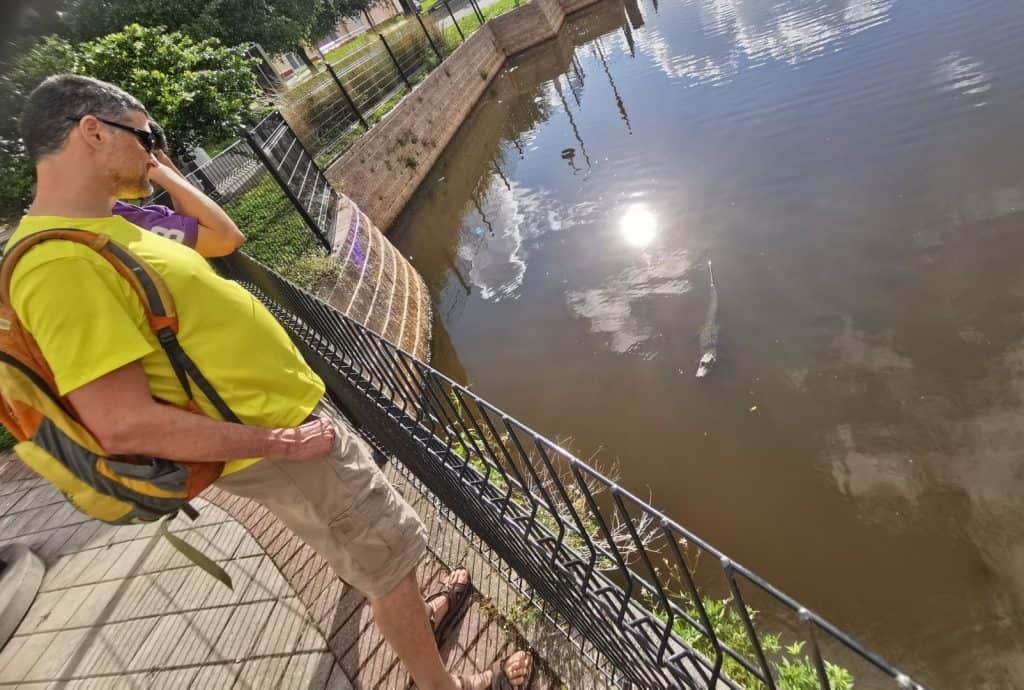
Where to Actively Look For alligators in Florida
Now that we've established that you can potentially find alligators pretty much anywhere in Florida, let's see how to find them in the wild when you're actually looking for them.
Alligators typically try to avoid humans. In the more popular parks and reserves, alligators became habituated to visitors, so you can find them on the banks of a river or lake, or view them from a boardwalk.
That's why planning a trip to one of the places on my list should give you the best chance of seeing gators in the wild. Alligators roam these areas with confidence and you're more likely to come across one.
When to see alligators in Florida
Winter is the best season for alligator viewing. During winter, alligators tend to come out of the water during the day and sunbathe on the banks to keep warm.
That's because alligators are cold-blooded reptiles. They adapt their behavior to try to keep their body temperature balanced.
Other good months for alligator viewing are during fall and spring. Depending on the weather, time of day, and location, you should also be able to see alligators on land during those months.
When is alligator mating season in Florida?
If you're visiting Florida between April and June and are looking to see alligators, be aware of the romance in the air.
During these months, alligators court and mate. That is also when they're the most territorial.
Don't let that deter you from going out to see alligators in the wild. On the contrary! Spring is a great time to see and hear alligators! Males roar and quack to announce their presence, so you get the full multi-media alligator experience.
Just be mindful, and give them enough space.
I was hiking the Orlando Wetlands on my own one day during mating season and could hear alligators roaring on both sides of the trail. Very exciting!
I turned around when I finally came across this alligator right by the trail. I could hear other males croaking all around us and was worried that this one would be too nervous to get back into the water if I got too close.
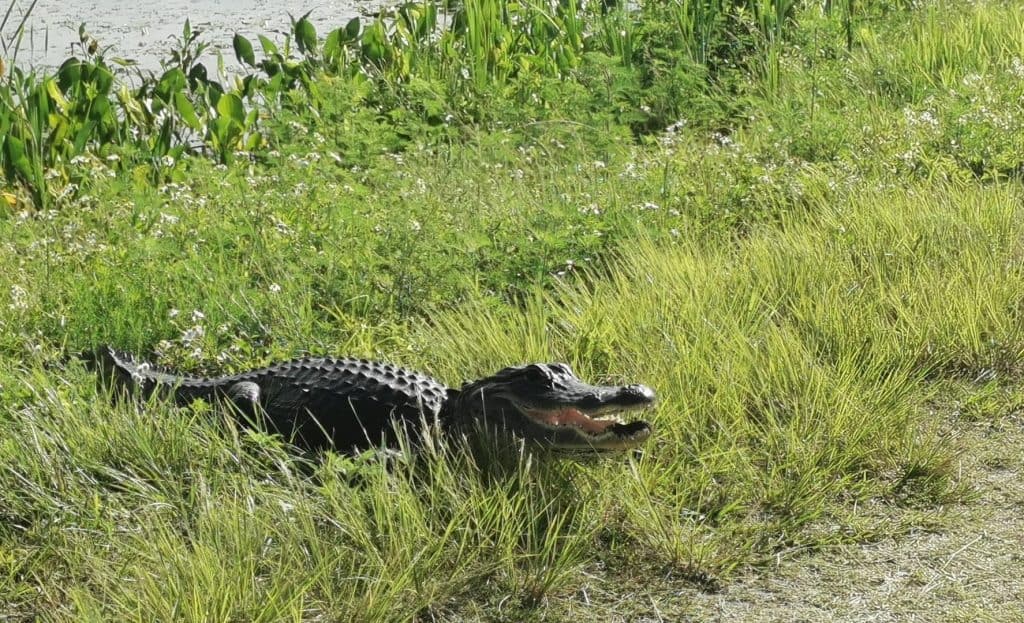
Alligator encounters—How to keep safe
Before we start talking about the locations, a word about safety.
Alligators are dangerous
Even a medium-sized alligator is a powerful animal, capable of snatching large prey from the banks and dragging it into the water. Once in the water, the alligator has the upper hand.
Alligators typically stalk their prey while they are camouflaged in murky water.
Keep pets and kids away from the water's edge
Alligators are also not likely to try to prey on a full-sized adult, but pets, children, and generally small and fragile people can all become targets.
When you come across an alligator resting outside of the water, it is just basking in the sun to regulate its body temperature. It's not out to hunt you and it's generally safe to pass by—just not too close and without harassing the gator.
Don't let its quiet demeanor lull you into a false sense of security. If provoked, that sedentary-looking animal can move very quickly.
I'm not trying to scare you away from going out to see alligators. I just want to make sure you have a healthy sense of respect for these animals.
What to do if you see an alligator in the Wild
If you spot an alligator while hiking—congratulations! Enjoy the moment and take the time to observe this majestic animal and take pictures from a distance.
Just how far you need to depends on the setup. In areas where alligators are used to having people around, it's common to see alligators relaxing in the sun with humans standing a few yards away. Otherwise, they're likely to back away if they sense the presence of humans.
Here are a few more safety rules—
- Make sure the alligator has room to move away, and never corner an alligator.
- Be respectful—don't try to poke an alligator, or throw anything in its direction. Taunting alligators is illegal and just plain wrong. It's also dangerous.
- Never feed an alligator! Alligators that come to associate people with food become dangerous and end up being euthanized by the authorities.
- Keep your distance from all alligators—even cute harmless babies. Momma alligators are very protective of their young and they're never far away. If you come across an alligator nest, don't get close.
As long as you practice common sense and respect the animals, you can enjoy a safe alligator experience.
What to do when there's an alligator on the trail?
If you visit any of the locations on my list, you could end up literally crossing paths with an alligator.
The safety rules above apply during such encounters. Give the alligator room and don't try to get close. If the alligator is crossing the path, let it finish the crossing (typically into a body of water).
If the alligator is resting right by the path, use common sense. If you feel uncomfortable, back away and find a different route.
Here's a video of one of our encounters where a rather big alligator was right by the path. We waited for it to cross and it wouldn't. We had to get by to get back to our car, so we figured it was giving us the right of way.
Can you swim with alligators in Florida?
The answer is no. And also yes.
No, don't try to swim with alligators in Florida. Alligators are dangerous and they're in their element in the water.
Here's the thing though.
There are some fantastic swimming holes in Florida, especially in the springs of Central Florida. We went swimming in several of them. There were certainly alligators not far from where we were swimming.
This is my son swimming at Blue Spring State Park. Note the sign that cautions you about the presence of alligators.
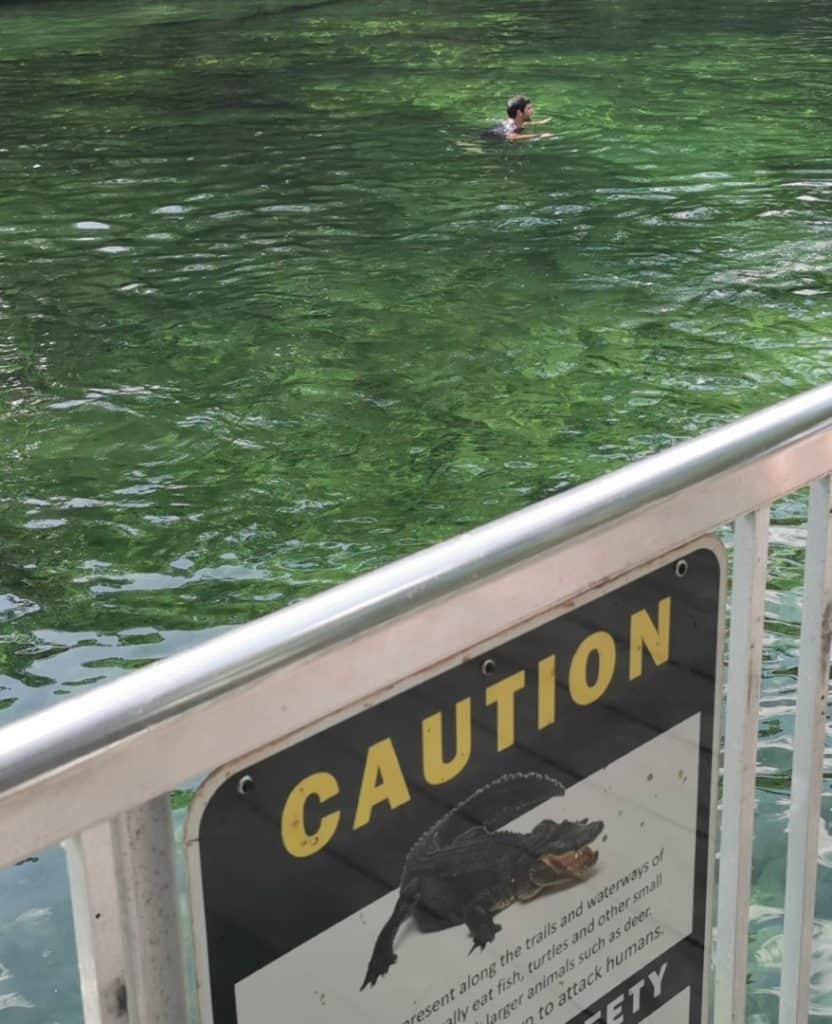
They were not kidding. This alligator was sunbathing 200 yards from the swimming area -
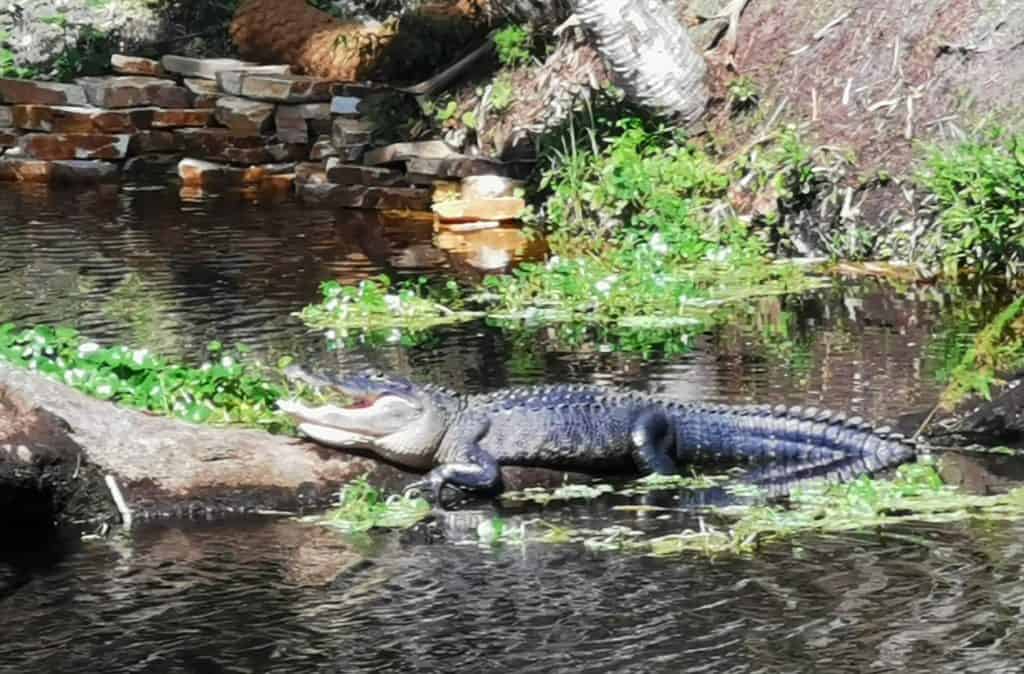
So, how do you go about it?
- Make sure you're swimming in clear (not murky) water where an alligator is less likely to stalk you.
- Avoid swimming during twilight hours. That's when alligators typically hunt.
- Stick to designated swimming areas.
Ok, let's start going through the various locations!
Where to see alligators in the Orlando Area
Most visitors to The Sunshine State end up spending time in the Orlando area.
While visiting Disney may be a Bucket List experience, adding an alligator hike to the itinerary is highly recommended!
Circle B Nature Reserve
Circle B Reserve is located in Polk County, just 40 minutes away from Disney World. The preserve is home to countless alligators, including this huge beast, estimated as being 13-15 feet long–
While we didn't get to see Godzilla above, we saw numerous alligators on the park's trails.
To see alligators in Circle B, look for trails that are near water. The Alligator Alley trail is always a good bet, as is the trail section called Wading Bird Way, where I took this picture—
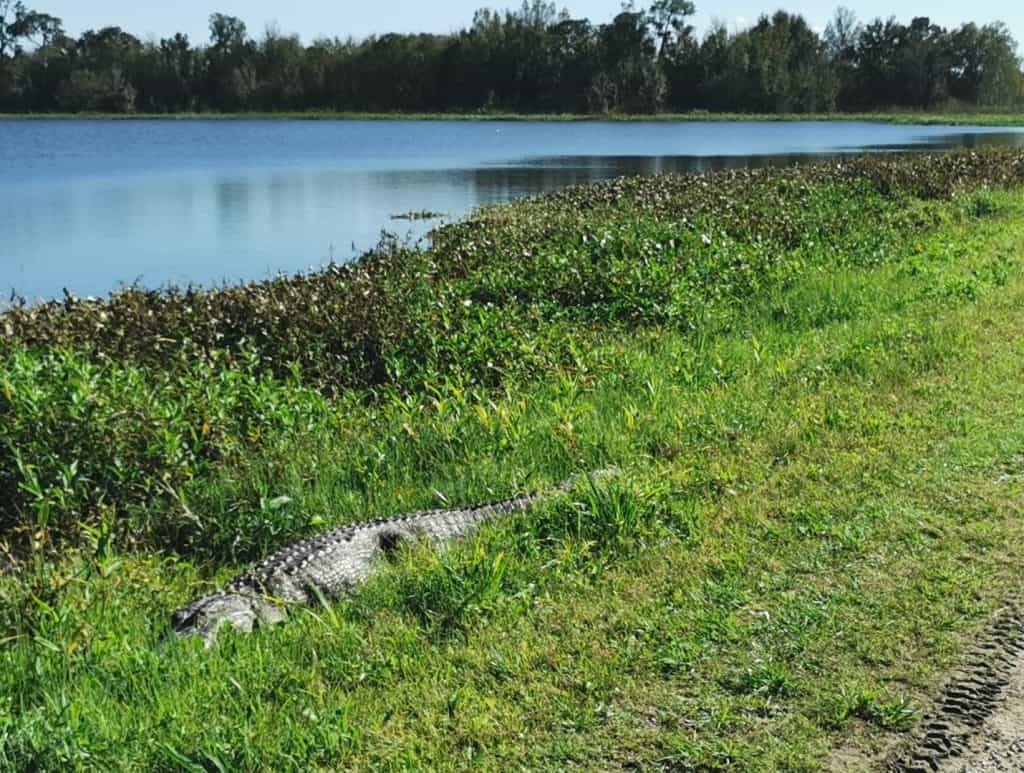
By the way, there was an alligator on the other side of the trail too—
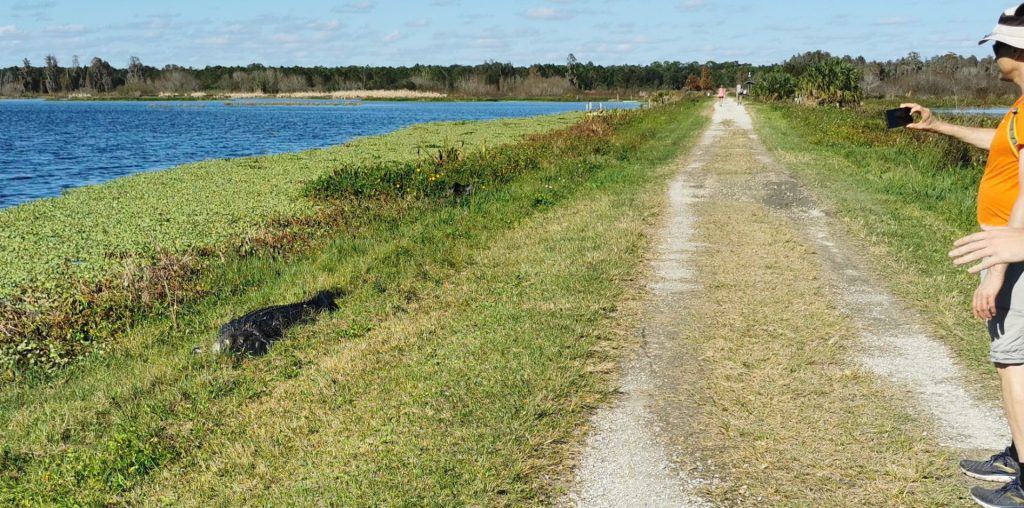
Circle B is very popular with locals, so if you come on a weekend or a holiday, try to get there early. There is a large parking lot but it can get full fast.
Lake Apopka Wildlife Drive
If you're too scared to walk the trails, or if someone in your party has difficulty walking, then the Lake Apopka Wildlife Drive (locally known as LAWD) is for you.
The drive is open during holidays and weekends (Fri-Sun) between 7 a.m. and 3 p.m. During other times, you can still walk or bike into the paths. The drive goes around the lake for 11 miles and it's a slow drive with everyone stopping to view the animals.
If you come during winter, you'll see alligators all along the drive, actively feeding, or just resting by the water. During the summer months, try to get to the Pump Station and check the water. We've seen dozens of alligators in the water at that spot.
Just keep looking out of the window as you drive. That's how we caught a glimpse of this one—
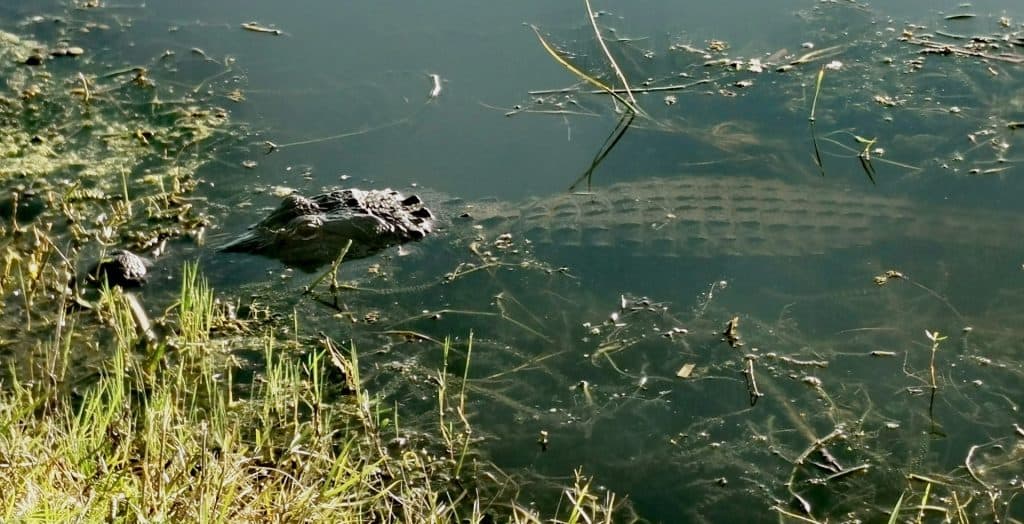
Black Point Wildlife Drive in Merritt Island
If you like the safari concept, there's another wildlife drive in central Florida that's worth the effort.
Just one hour away from Disney, you get to Merritt Island and head out to Black Point Wildlife Drive. It's a great place to visit while on the Space Coast, so if you have a night to spend there, I would combine the drive with a visit to Kennedy Space Center (and maybe even watch a rocket launch!).
If you're going just for the alligators, this isn't your best bet though. There's no shortage of them on Merritt Island, but they are shyer there and you're less likely to find them near the path.
That's why I haven't included this location in the original list. I just thought I'd mention it here in case you liked the idea of driving around to see Florida wildlife.
We did see—and almost stepped on—a dusky pygmy rattlesnake there, when hiking the Allan D. Cruickshank Memorial Trail there!
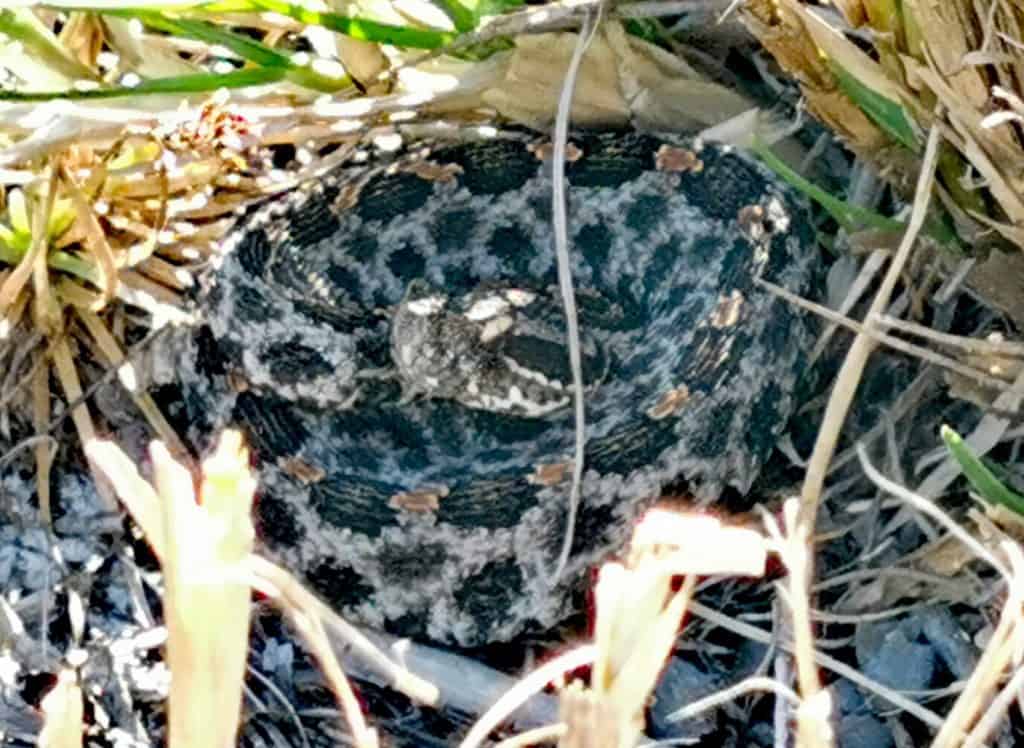
The Orlando Wetlands
If you're in Central Florida anytime between December and February, do yourself a favor and visit this place. Then come back here to thank me in the comments section. It's a 45-minute drive from Disney and worth every minute.
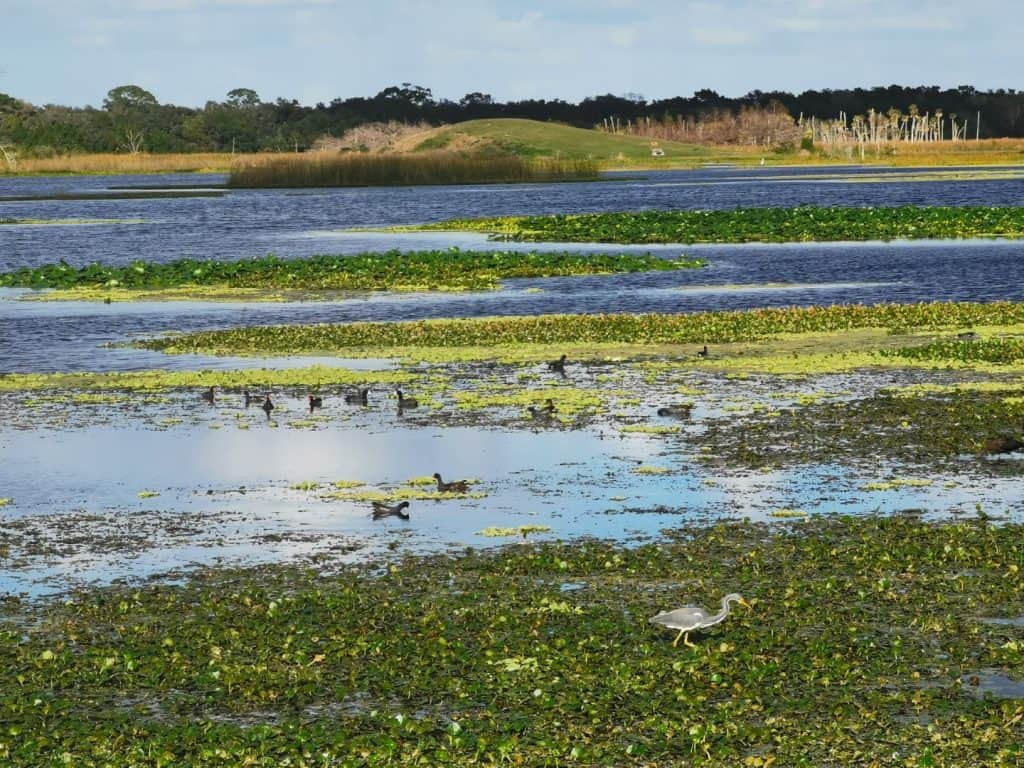
This park is a little slice of heaven during the winter, with TONS of migrating birds crowding the lakes. The soundtrack is like something out of Jurassic Park.
We're here to talk about how to see alligators, so I'll refrain from sharing more photos of softshell turtles, snakes, huge sandhill cranes, otters, vultures, and numerous other creatures we got to see up close in this park.
The Orlando Wetlands are home to thousands of alligators. I haven't counted them, but I got to see hundreds congregated in single ponds, so I'm pretty sure the population count is in four digits.
Check out this feeding frenzy we saw (more than once) during the spring—
The best place to see alligators on land in this park is by hiking the Alligator Alley trail—
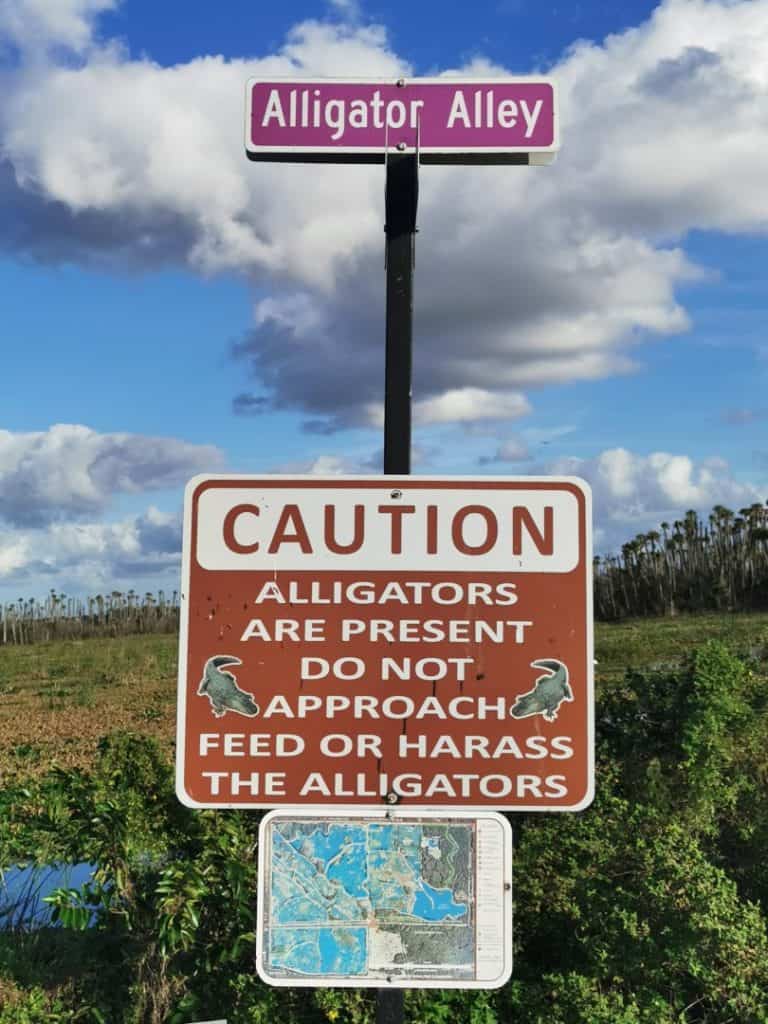
Try to get there on a cool day, during the afternoon hours. That's when these reptiles tend to get out of the water to get warm (see video and photos above!).
But you can also catch glimpses of them in other spots in the park. Just keep looking—
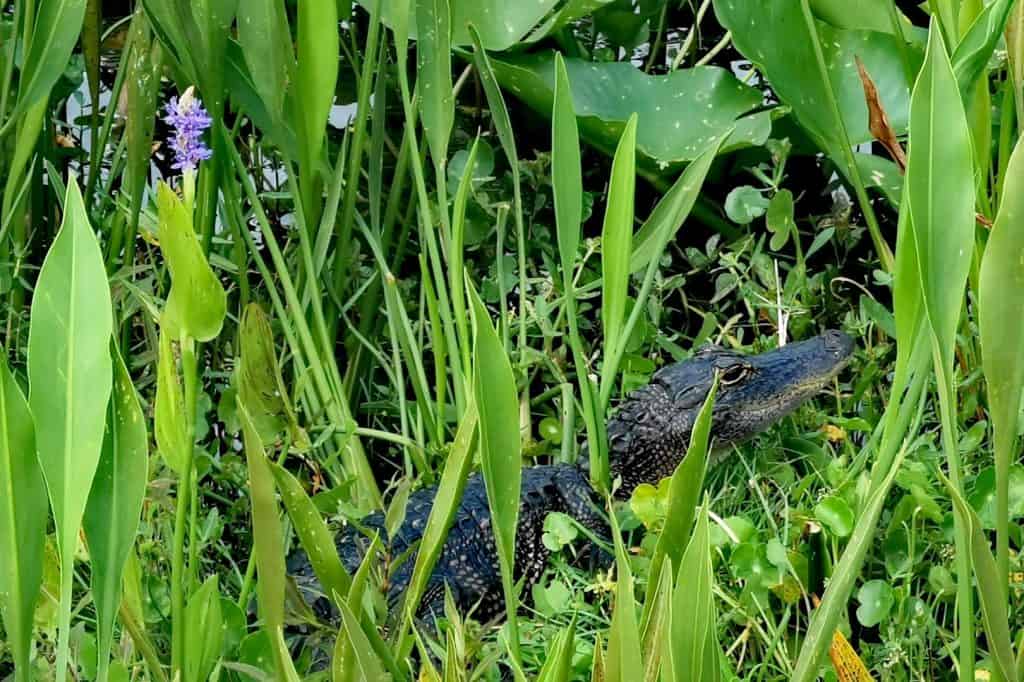
And of course, you can see them in the water too!
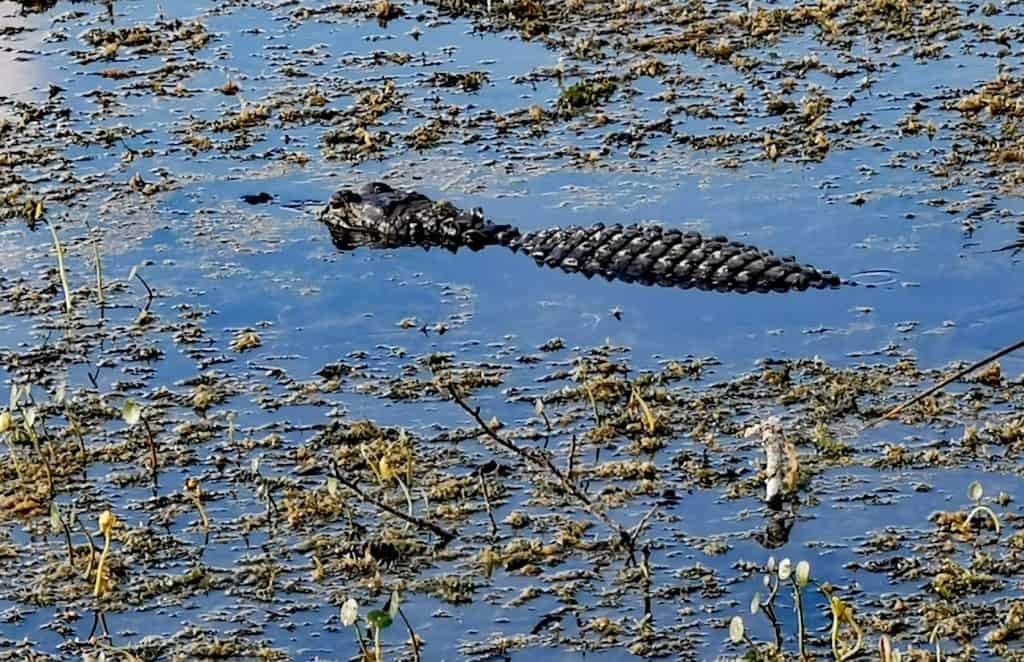
The park is open daily between dawn and dusk. It's free to enter and there is a small visitors center as well as clean bathrooms.
There's ongoing construction around the entrance as they seem to be building a new visitors center. You won't notice it once you enter the park itself. Check for the current status here.
Black Bear Wilderness Area
If you're looking to hike in Central Florida, the Black Bear Wilderness area has some great options. Only 40 minutes away from Disney, you have a good chance of seeing alligators there. We've seen several alligators at this location.
And as the name suggests, there's also the chance of spotting a bear! We weren't that lucky, but you might be.
Kayaking in the Springs of Central Florida
We mentioned swimming in the local springs. You can also kayak in these places.
We've spotted alligators on the banks and in the water when kayaking in Blue Spring State Park, Silver Springs State Park, and Wekiwa State Park, so I thought I'd include the experience as a potential gator-sightseeing venue.
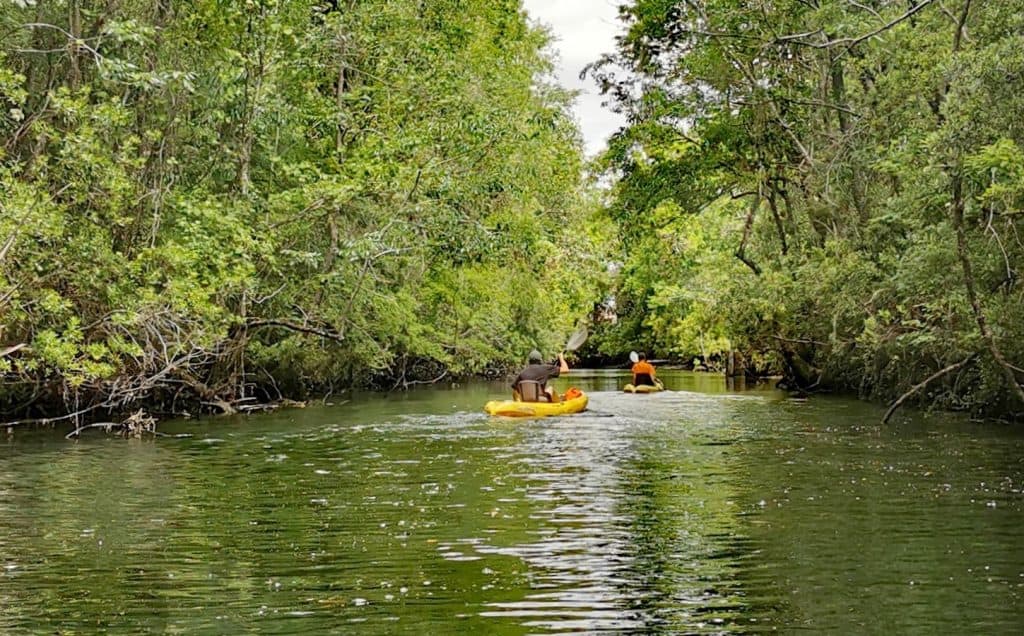
Is it scary?
It was to me, at first. But here too, alligators typically stay away from humans. If you see an alligator crossing the river, give it space and you should be ok.
Kayaking offers the added benefit of seeing manatees! Especially during the winter months.
What about Lake Jessup?
You may have seen Lake Jessup mentioned in other online lists, along with the statement that this lake holds the largest population of alligators in Florida.
While I'm sure there are numerous alligators living in the lake, I think simply saying "Lake Jessup" isn't very helpful.
We've visited Lake Jessup and strolled along parks on the water. We couldn't find good spots where you get to see alligators. I haven't heard local alligator fans mention any locations around the lake either.
I have heard that you can see them hanging around the Lazy Gator restaurant there, where you can also take airboat rides, so if you're near Lake Jessup, you can check out that location. Otherwise, I would suggest trying the places on my list instead.
Where to see alligators in the Miami area
Miami is not only a popular tourist destination, but it's also close to the Everglades National Park—a prime gator spotting location that I had to include in this guide.
If your trip focuses on Disney, you may be wondering if it's worth going all the way south just to view alligators in the Everglades.
In my opinion, national parks are typically worth visiting whenever you can. I even created a guide dedicated to visiting Everglades National Park, so yeah, if you can, I'm all for adding this park to your itinerary.
Just know that if seeing alligators is your sole purpose, you don't have to travel all the way from Orlando to this national park. Using the list above, you can get your share of alligator encounters—all within an hour's drive from Disney.
However, if your Florida trip takes you to Miami, then visiting the national park is a great idea and will get you close to some of the big reptiles. In fact, you may be able to see both crocodiles and alligators if you head that way! More on the difference between the two species later on in this post.
Seeing Alligators at Everglades National Park
The Everglades National Park is huge and mostly inaccessible by land. Visitors typically get to two of the four main visitor centers that are closest to Miami: the Ernest F. Coe Visitor Center and the Shark Valley Visitor Center.
Both of these areas are prime alligator viewing areas.
Ernest F. Coe Visitor Center & Royal Palm Visitor Center
Located about an hour away from downtown Miami, you can start your Everglades journey by stopping at the Ernest F. Coe Visitor center. See the displays to learn more about the park and go outside to look at the serene clear water of the Everglades. We were surprised by how clear the water was—not swampy at all!
While you may be able to spot alligators right by the visitor center, a better place to try and find them would be the nearby Royal Palm Visitor Center (a few minutes of additional driving into the park will get you there).
This is where you can hike the famous Anhinga Trail for some great wildlife viewing. Most of the path is boardwalks, but where it's not, alligator crossings are common (especially during winter).
When we were there in September, we spotted a couple of alligators in the water, as well as this one on the ground—
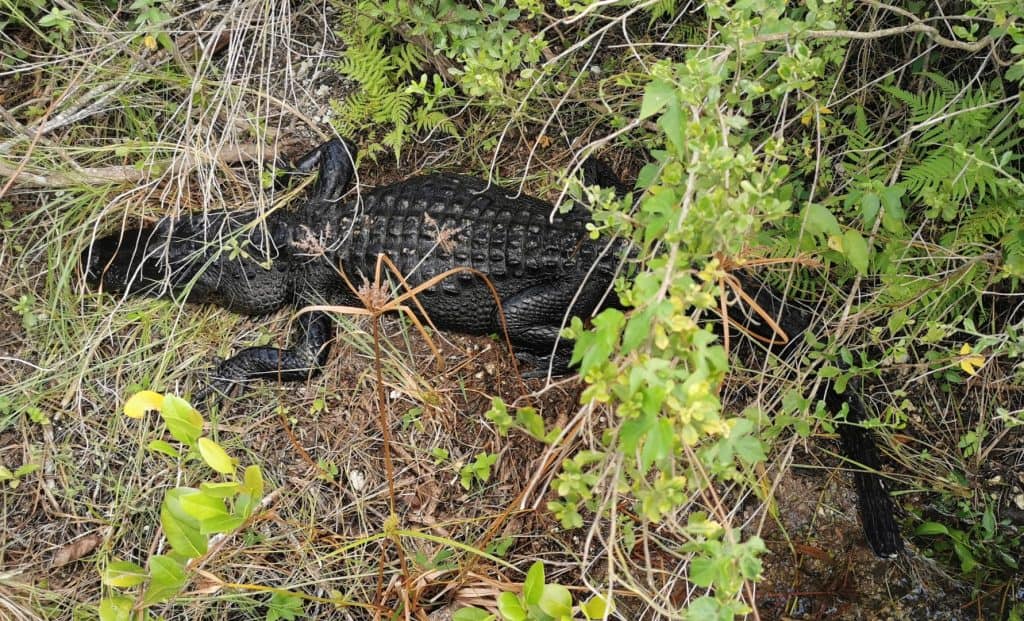
While we were close to the big lizard, the photo was taken from the safety of an elevated boardwalk.
Shark Valley Visitor Center
The Old Tamiami Trail - aka Highway 41 - is a historic road connecting Tampa and Miami right through the Everglades National Park.
If you leave Miami and drive this road for about 40 minutes, you'll reach the Shark Valley Visitor Center where you are very likely to see alligators.
When we visited during September, most of the alligators were in the water but we still saw a large one crossing the trail, just yards away from where we were.
Visiting during January, we were rewarded with seeing dozens of alligators on the banks of the streams. My husband rented a bike there (available at the center) and rode the entire loop. Yes, right next to the alligators.
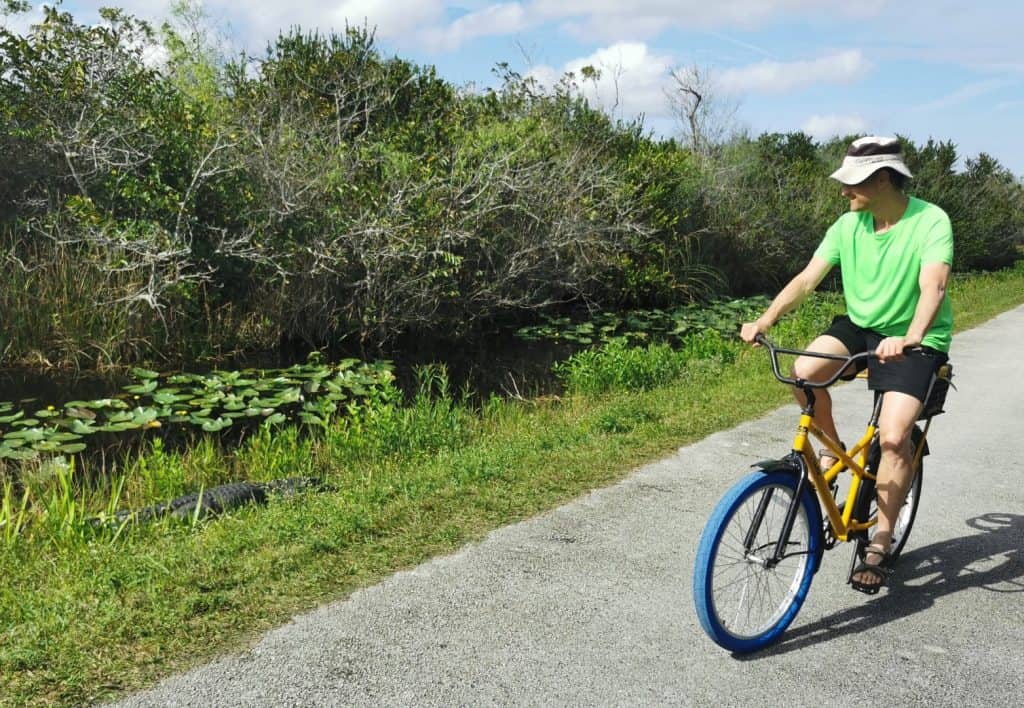
My son and I hiked for a few miles and found an alligator nest with babies! It was like a scene right out of Jurassic park—with a big momma alligator hanging by in the water. Aren't they cute, though?
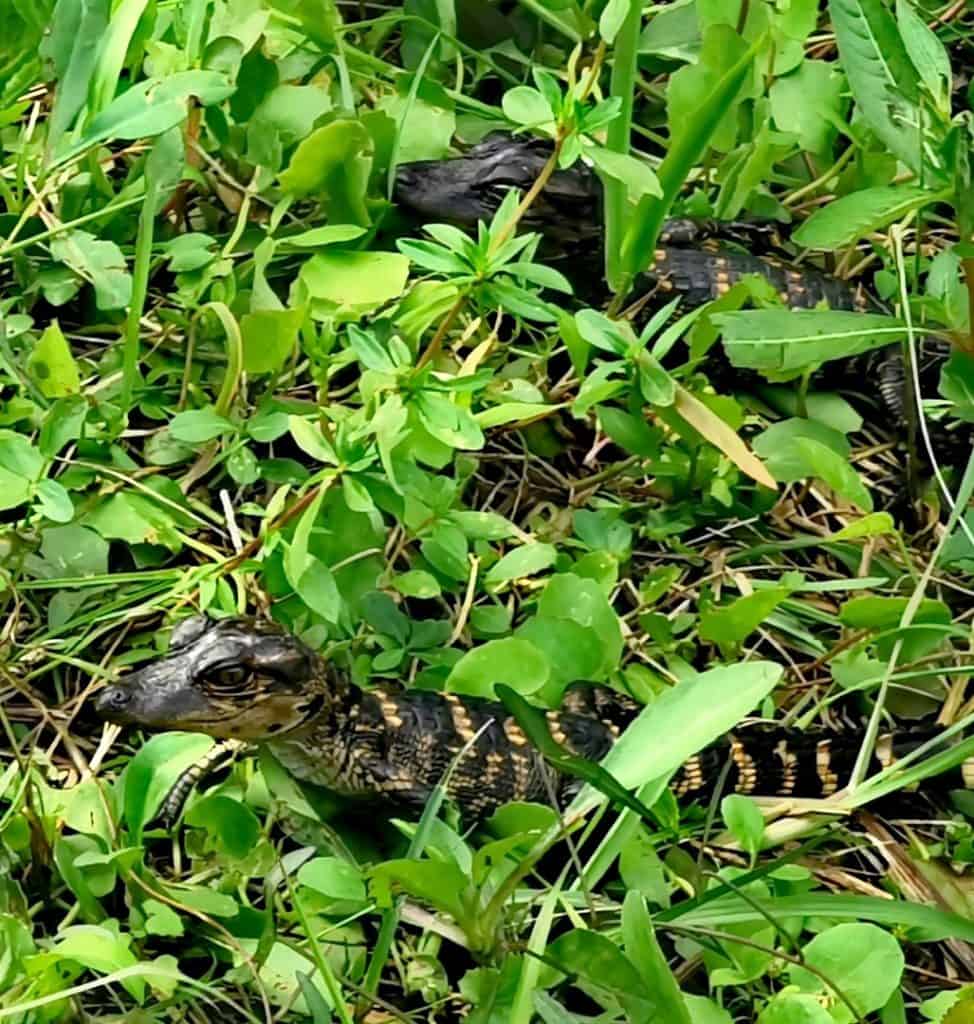
You don't have to go far to see adult gators in Shark Valley. These big boys were sunbathing right by the visitor center—
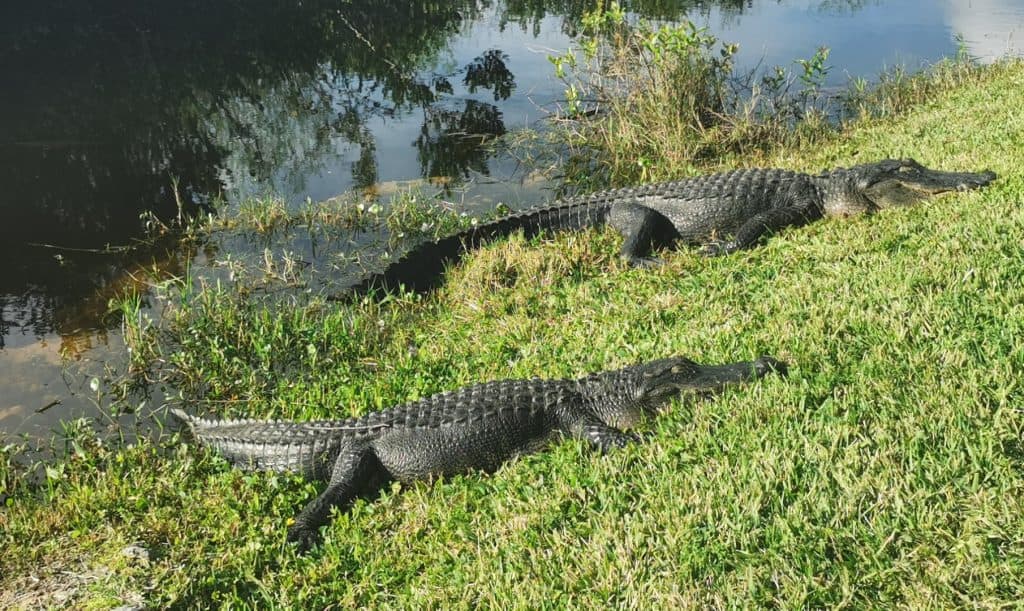
If you prefer to take it easy and avoid hiking in the heat—or just prefer the added safety—consider taking the tram ride in Shark Valley. The tram tours go out from the visitor center and provide you with a fun, safe, and fully-narrated tour of the same loop road.
Can you see Alligators in the Florida Keys?
Are there alligators in the Florida Keys? Yes. It's Florida. There are alligators present pretty much everywhere.
They're not easy to spot though and become rarer the further away from the mainland you go.
Alligators can tolerate salt water for a limited amount of time, but they prefer freshwater. A lot of the wet areas in the Keys contain brackish water and alligators prefer to stay away from those. The Keys are also densely populated, not leaving a lot of room for wildlife around water sources.
When we were in the Florida Keys, we didn't see any alligators. Just a lot of huge iguanas.
Where to see alligators in the Tampa area
If you're visiting the Tampa area, there are many opportunities to see alligators around ponds, lakes, and streams. Alligators are common there as they are anywhere in central Florida.
I've only visited Tampa twice, and we weren't looking for alligators while there. If you're looking for alligators in the Tampa area, my suggestion would be to Google the names of state parks and reserves nearest you and look at the reviews and photos.
I'm including Tampa here because there's one place alligator lovers should not miss out on if in the area—
Myakka River State Park
An hour out of Tampa, Myakka River State Park is famous for the large population of alligators living there. Specifically, in one area of the park known as The Deep Hole.
Deep Hole is a small lake in the park where hundreds of large alligators congregate during sunny winter days.
If you want to visit Deep Hole, you need to plan ahead. There is a limited number of permits available daily and they are distributed on a first-come-first-serve basis. Your best bet is to try and visit during weekdays, and even there, try to show up early.
Taking an Airboat ride to see alligators
If you don't like the idea of hiking alongside predators or just prefer to view wildlife from the comfort of a boat, an airboat ride in the Everglades may be right for you.
There are multiple airboat ride operators all over Florida. Your best bet is to search for "airboat ride" in Google maps and see what comes up in the area you're about to visit. Follow the review scores to find a good operator—that's what I typically do.
We did go on an airboat ride while in Florida. We chose Wild Florida Park and Tours as the combination of a ride and animal park worked for us on that day.
The airboat ride was nice and we did see a few alligators in the water. From the boat, you mostly get a glimpse of the top of the animal as it's trying to get away. Still, the ride itself is fun.
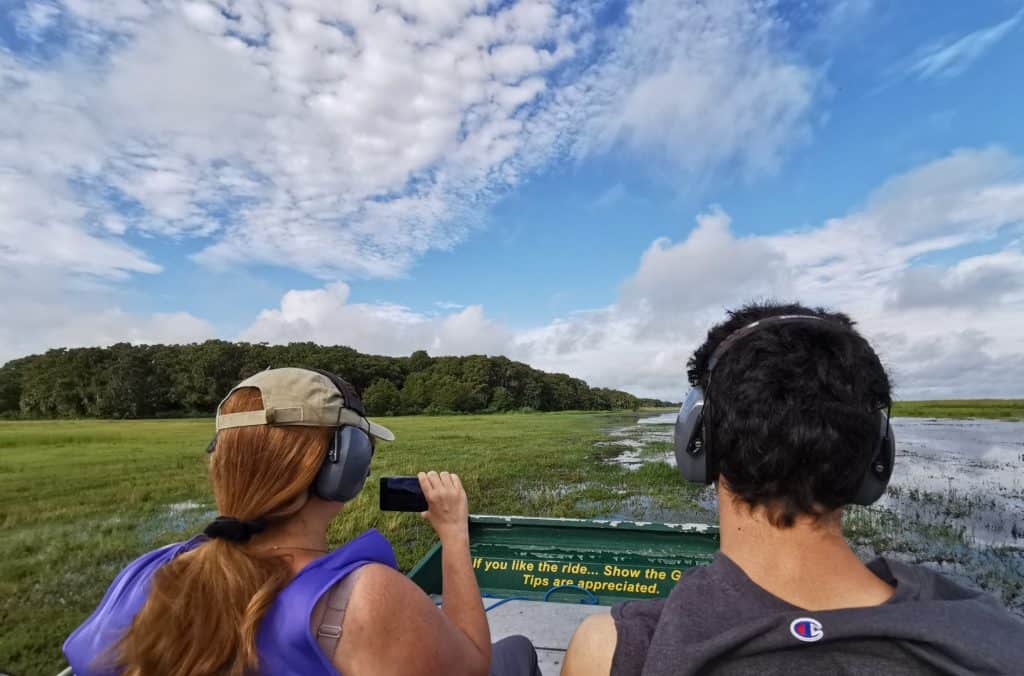
The airboat motor is extremely loud, and while they do provide you with ear protection, it may be too loud for some people.
The "zoo" section of the place was nice too. The reptiles there have all been rescued from situations where they would have otherwise been euthanized. They seem to be kept in appropriately sized enclosures and receive good care.
The park does offer several educational programs every day, so you can use the opportunity to learn about alligators and other animals and watch the staff interact with large alligators.
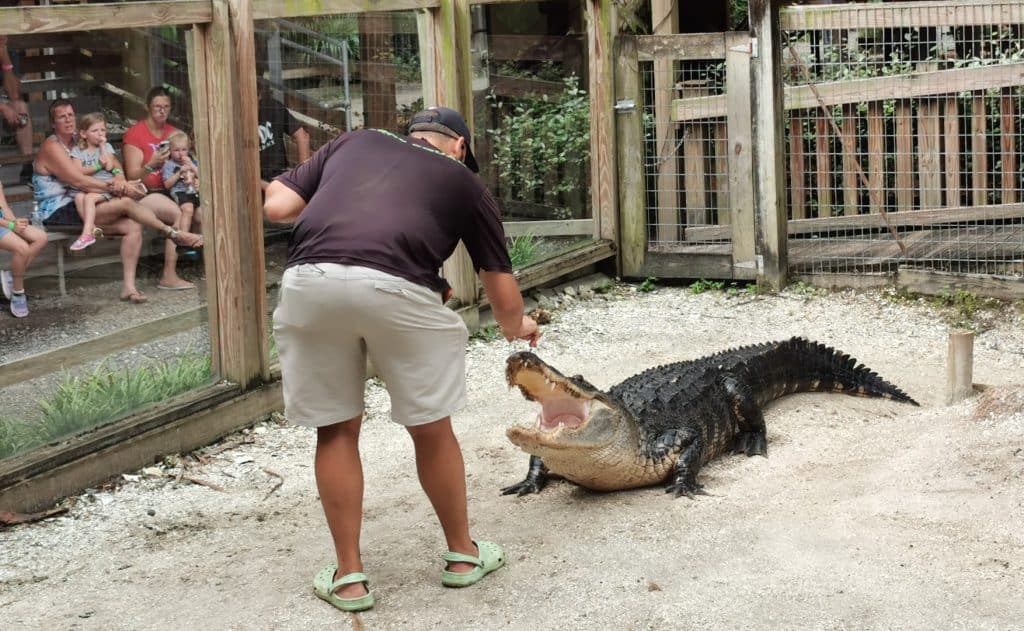
And now, as promised, a few words about the question so many people have—
Are these alligators or crocodiles?
Both alligators and crocodiles are members of the Crocodilian family and are native to Florida.
Generally speaking, American crocodiles are rare. You are far more likely to see alligators in Florida.
As a rule of thumb, if you're in the Orlando area, you're looking at alligators. Crocodiles are found much further to the south. There is a small population of crocodiles in the Everglades National Park. Several crocodiles have been spotted regularly in other areas—all of them in Southern Florida.
How to tell if you're looking at a croc or a gator?
If you're in the Everglades and wondering if you're looking at a crocodile or an alligator, here are two simple rules to remember—
- Alligators have wider U-shaped snouts whereas crocodiles have narrow snouts.
- When an alligator's mouth is shut, you can only see the top teeth. With a crocodile, you can see both top and bottom teeth.
You can view both traits and read more about crocodiles on this page by the National Parks Service.
Go out and find your gators!
Seeing real alligators in the wild is exciting! I hope this guide helps you add those special moments to your Florida itinerary!
And if you're still looking for more suggestions, we have tons of Florida guides on the site. Here are a few suggestions—
Florida Itineraries for One Week (7 Days)
66 attractions along the Florida Keys
11 Florida Bucket List Destinations
If you have any questions or suggestions, please leave me a comment here.
Locals - if you can add your own favorite spots in the comments, that will be fantastic. The readers of this blog typically go through the comment section, so additional information there will be useful. Thank you!
